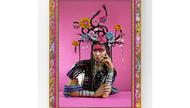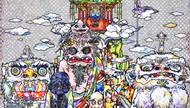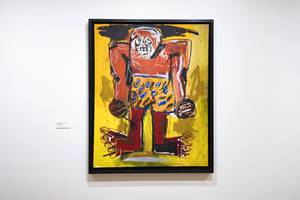
Primal Water: An Exhibition of Japanese Contemporary Art Through October 21; daily, 10 a.m.-7 p.m.; $12-$14. Bellagio Gallery of Fine Art, 702-693-7871.
Thirteen transparent tubes drape from the ceiling in Sadamasa Motonaga’s “Work (Water)” at Aria Resort. Taut and tentacled like intergalactic octopi, they hang 47-feet-high above the lobby, their mirrored reflections swimming in the polished granite floor below. Each tube has a full belly of bright color—fuchsia, indigo, scarlet, pine—that shines like a gem in the daylight streaming through the windows. Transcending its humble materials (polyethylene, water, dye and rope), Motonaga’s installation partakes of the sublime, as fresh and exciting today as it was when first exhibited 62 years ago.
“Work (Water)” is one of the headliners in Primal Water: An Exhibition of Japanese Contemporary Art curated by Midori Nishizawa and facilitated by Tarissa Tiberti, Executive Director of MGM Resorts Art & Culture. An ambitious show, Primal Water spills out of the gallery confines—in addition to Motonaga’s masterpiece at Aria, an adjacent arcade screens three arty videos. The exhibition also questionably overflows the usual bounds of “contemporary art,” with 10 of its 14 artists born before 1950. Even the “water” theme seems hard to contain, since several of the 28 works—including photographs, ceramics, sculptures, installations, paintings, films and a silkscreen—link conceptually, rather directly, to the exhibition title.
Among the stunners are pieces transforming water’s fluid properties into intriguing static forms. Noe Aoki’s “Cloud Valley,” for example, is more like a 3D drawing than a sculpture, its delicate iron “bubbles” creating a “geyser” of negative space. Machiko Ogawa’s “Breathing Bubbles” is grounded by comparison—the installation features magical aqua froth crystalized inside primitive ceramic vessels probably worshipped by an alien civilization. Also captivating is Yasuaki Onishi’s “Vertical Emptiness,” with its locally harvested mesquite hanging upside-down from the ceiling and covered first with hot glue, then liquid nitrogen. The fluids dripped and hardened into a thready frozen scene of tufted “icicle” strings, producing a miniaturized primeval panorama.
While many of the midcentury works in Primal Water opt for concept and emphasize materials (lead, cloth, polyurethane, polyester), others welcome an emotional connection. Consider Shoji Ueda’s photograph “Seascape”—its fragile, off-kilter flag pokes from the waves, humanizing the immensity of nature. Conveying a more pointed spiritual message, Rei Naito’s “Untitled” and “Human” installation combines a small, glass jar brimming with tap water and a hand-carved, two-inch wooden figurine. The little person is proxy for the viewer, witnessing the sacred role of water in life.
Primal Water has a rigorous, academic feel. Although the pieces were likely chosen because of their representative place in the Japanese canon, they don’t always vividly communicate the major accomplishments of artists better known in Asia and Europe than in the U.S. All the more reason to see these artworks here while you can.






